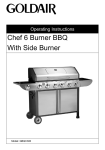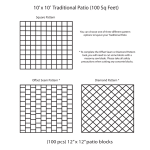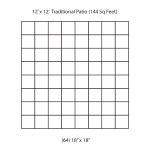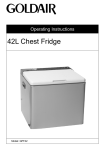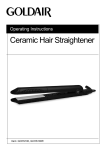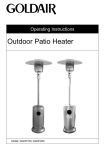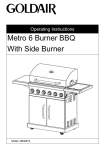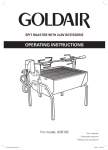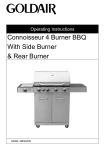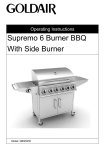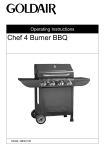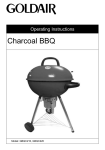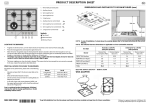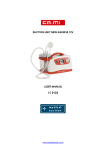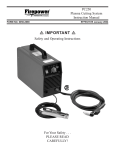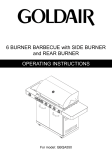Download Outdoor Patio Heater
Transcript
Operating Instructions Outdoor Patio Heater Model: GGOH300 Read Me First Page 1 Outdoor Patio Heater Please read these instructions & user manual carefully. o Take extra care when unpacking and assembling your Goldair Patio Heater. Some edges may be sharp from the manufacturing process and may result in cuts if not handled with care. o Before attempting to assemble your Goldair Patio Heater, ensure all parts are correct and contained within the box as per the components list. o Goldair suggests laying out all components on a large flat surface and removing any plastic or protective material before assembling your Patio Heater. o It is vital for optimum use of the Patio Heater that you Purge the gas line prior to attempting to ignite the Patio Heater. o Do not dispose of packaging until completely satisfied with assembly of your Patio Heater Please refer to your user manual for operating instructions, further information or trouble shooting before you call the Customer Service number listed within the user manual. If your Patio Heater has any Stainless Steel please note the following: Note: Stainless Steel will rust. Failure to store, clean & maintain your Patio Heater regularly will result in Stainless Steel ‘tea staining’ & rusting. Consequently it will not be covered by the warranty. Goldair recommends the use of stainless steel protectors & cleaners to also prolong the life of your Patio Heater. Please refer to your user manual. Read Me First Page 2 Gas Leak Testing It is important that you leak test the Patio Heater before first use and every time the gas cylinder is refilled and reconnected to the Patio Heater. To complete a Leak Test: • Make sure all the control knobs are OFF. • In a small container, mix up a solution of water and detergent/soap. Mix the solution well (about the same concentration as washing up water). • Turn the cylinder ON by rotating the knob to the open position. • Using a brush or spray bottle apply the soap solution to the gas line and each join in the gas line including: • The gas connection at the inlet of the Patio Heater • The gas hose • The gas connection at the gas cylinder • If bubbles appear, there is a gas leak. • If the leak is at the connection, re-tighten and re-seal. • If the leak is anywhere else or you cannot resolve the leak by tightening the connection DO NOT PROCEED. • Replace gas hose and regulator. • Replacement hose and regulators can be purchased from your local BBQ retail specialist. Read Me First Page 3 Purging The Gas Line It is very important to purge the line free from air to get the LPG to the head unit. o o o o o o o Turn off LPG Cylinder. Disconnect LPG Cylinder. Turn the gas burner knob on for a minute or so releasing air from the line. Turn off burner knob. Reconnect the LPG Cylinder. Turn the dial on the LPG Cylinder SLOWLY to the on position. Press the control knob in allowing gas to come up the line and bleed it (pressing control knob in) for not more than 1 - 2 minutes or until you smell gas. o A five minute complete shut off period is necessary before lighting. If a new tank has just been connected, please allow at least one minute for the air in the gas pipeline to purge out at the High position. A five minute complete shut off period is necessary before lighting. Safety Guide Page 4 • Do not operate this Patio Heater before reading the instruction booklet • Do not place articles on or against this Patio Heater • Do not use or store flammable or combustible materials, chemicals or spray aerosols near your Patio Heater • Do not operate this Patio Heater indoors; the Patio Heater is for outdoor use only • Do not obstruct any ventilation of the Patio Heater • Do not light or operate with cover on • Never store a spare LPG cylinder near your Patio Heater. This could cause excess pressure to be expelled through the relief valve resulting in fire, explosion, or severe personal injury including death • LPG gas is heavier than air and will collect in low areas, proper ventilation is extremely important • Keep the ventilation opening of the LPG cylinder enclosure free and clear from obstruction and debris • Do not insert any foreign objects into the valve outlet. Damage may result, causing a leak, possible explosion, fire, severe bodily harm or death • Children and adults should be alerted to the hazards of high surface temperature, burns and clothing ignition • Never leave children unattended in the area where the Patio Heater is being used. • Do not store items of interest to children around, below or in the shelf of the Patio Heater • Never allow children to sit or stand on any part of the Patio Heater Safety Guide Page 5 Always choose a safe location for the Patio Heater, keeping in mind the safety precautions outlined. Ensure all packaging has been removed from the unit before use. NOTE This Patio Heater shall only be used in an above ground open air situation with natural ventilation, without stagnant areas, where gas leakage and products of combustion are rapidly dispersed by wind and natural convection. Any enclosure in which the Patio Heater is used shall comply with one of the following: An enclosure with walls on all sides, but at least one permanent opening at ground level and no overhead cover. (Refer to Figure 1). Within a partial enclosure that includes an overhead cover and no more than two walls. (Refer to Figure 2 and Figure 3). Within a partial enclosure that includes an overhead cover and more than two walls, the following shall apply: • At least 25% of the total wall area is completely open, (refer to Figure 4), and • At least 30% of the remaining wall area is open and unrestricted, (refer to Figure 5) In the case of balconies, at least 20% of the total wall area shall be and remain open and unrestricted. Figure 1 - Enclosure with walls on all sides but no overhead cover Figure 2 - Partial Enclosure with overhead cover and no more than two walls Figure 3 - Partial Enclosure with overhead cover and no more than two walls Figure 4 - Open side at least 25% of total wall area. 30% or more in total of the remaining wall area is open and unrestricted. Figure 5 - Open side at least 25% of total wall area. 30% or more in total of the remaining wall area is open and unrestricted. Safety Guide Page 6 A strong gas smell or hissing sound of escaping gas indicates a serious problem with the Patio Heater or LPG cylinder. Failure to immediately follow the steps listed below could result in a fire or explosion that could cause serious injury, death or property damage. • • • • • • Shut off gas supply at cylinder Turn the control knob of the Patio Heater to the off position Extinguish any open flame Get away from the LPG cylinder Do not try and fix the problem yourself If gas odour continues or you cannot extinguish fire, call fire brigade. To prevent fire and smoke damage, remove all packaging material before operating Patio Heater. HOSE ASSEMBLY AND SAFETY A leak test (Procedure located on Page 2 of this manual) must be carried out prior to using the Patio Heater for the first time and each time the gas cylinder is refilled, or each time the gas hose and gas regulator have been disconnected. Check all gas hose and line connections for damage, cuts or cracks each time you use the Patio Heater. If the hose shows signs of deterioration or damage, complete a leak test to identify any leaks and if required replace the hose. The hose must remain free of kinks and sharp bends. Never puncture or put stress on the hose or fittings. Hose connection is located at the lower front area on the right side wall of the main body of the Patio Heater. Replacement hose and regulators can be purchased from your local BBQ retail specialist. Leak Test procedure is located on Page 2 of this manual. BURNERS The location of the tube burner to the jet is vital for safe operation. Check to assure the jet is inside the burner tube before using the gas Patio Heater SPIDER AND INSECT WEBS Some times spiders, ants and other insects climb into the tube burners, gas lines and other areas of the Patio Heater. The insects can spin webs, build nests and lay eggs. The webs or nests can be very small, but they are very strong and can block the flow of gas. To avoid this occurring, clean burners prior to use, after storing, at the beginning of your Patio Heater season or after a period of one month with out use. Guards are on the air intakes in an effort to reduce this problem, but it will not eliminate it. An obstruction can result in a “flashback” (a fire in the burner tubes). The burner may still light, but the obstruction does not allow full gas flow to the burners. NOTE: Complications arising from spider and insect webs built up inside gas lines are expressly excluded from Warranty Safety Guide Page 7 GAS CYLINDER INFORMATION 1. This Patio Heater is designed to be used with a gas cylinder not exceeding 9KG. 2. The gas cylinder supply valve must be turned off when the Patio Heater is not in use. 3. Gas cylinders must be stored outdoors, out of reach of children and must not be stored in a building, garage or any other enclosed area. 4. The gas cylinder used must incorporate a safety collar to protect the valve assembly. 5. Any LPG cylinder not attached to the Patio Heater for use should be stored outdoors and well away from the Patio Heater. IMPORTANT 1. When disconnecting and removing the gas cylinder for the purpose of refilling, always follow these procedures. 2. Ensure that all gas control valve on the Patio Heater and the gas cylinder are turned off before disconnecting the regulator from the cylinder. 3. Do not smoke or use a naked flame near the Patio Heater or gas cylinder while disconnecting the gas line between the Patio Heater and gas cylinder. 4. Remove the gas cylinder from the enclosure before disconnecting the regulator from the Patio Heater. 5. Tighten all connections before placing the gas cylinder back in its enclosure. 6. The gas leak testing procedure should be conducted every time the gas cylinder is refilled and reconnected to the Patio Heater prior to using the Patio Heater (Procedure located on Page 2 of this manual). Warning For safe use of your Patio Heater and to avoid serious injury: DO NOT let children operate or play near the Patio Heater. KEEP Patio Heater area clear and free from materials that burn. DO NOT block holes in bottom or back of Patio Heater. Check burner flames regularly. Use Patio Heater in well-ventilated space. NEVER use in enclosed spaces such as a carport, garage, porch, covered patio, etc. DO NOT use charcoal or ceramic briquettes in a gas Patio Heater. Safety Guide Page 8 REGULATOR CONNECTION 1. Check that the control knob is in the ‘Off’ position. 2. Make sure the cylinder valve is off. 3. Remove the protective cap from the cylinder, if present. 4. Leak test the connection with a soapy water solution (Procedure located on Page 2 of this manual) NOTE 1. Never use a rusty or dented gas cylinder with a damaged gas valve 2. Never fill the gas cylinder beyond 80% capacity 3. Always have the gas cylinder filled by an authorized LPG supplier 4. If you have any questions concerning assembly or operation, consult your dealer or LPG Gas Company. 5. When used always place the Patio Heater and cylinder on flat level ground. 6. You will need to have the LPG cylinder serviced or replaced every ten years. The date of the last service should be stamped on the neck of the bottle. 7. Always use a spanner to tighten all gas fittings. Safety Guide Page 9 • Proper clearance from combustible materials must be maintained at all times. The minimum clearances is as follows: Perpetual: 700mm Ceiling: 1500mm • Turn off all gas valves including cylinder after use. • Do not allow build up of unburned gas. • Accessible parts maybe very hot. • Always wear protective gloves when handling hot components • Never dismantle control valves • Never modify the construction of the Patio Heater or the size of any burner, injector orifice or any other components. This will void your Warranty. • Never move the Patio Heater during use • The use of unauthorised parts will void your Warranty and can create an unsafe environment and conditions of use. • Never disconnect any gas fittings while the Patio Heater is in use. • In the event that a burner goes out and gas escapes, turn off the burner knob, Wait 5 minutes before attempting to relight the Patio Heater. • Certain materials or items, when stored under or near the Patio Heater, will be subjected to radiant heat and could be seriously damaged. Clothing or other combustible materials should not be hung from the Patio Heater, or placed on or near the Patio Heater. Combustible materials are considered to be wood, compressed paper, plant fibres, plastic or other materials capable of being ignited and burned Parts Diagram Page 10 Assembly Procedure Page 11 Note: Tools required for assembly - 2 x adjustable spanners, Medium Philips screwdriver. Assembly Procedure Page 12 Step 6. The Patio Heater is intended to be used with a standard 9kg LPG cylinder. This is the type of cylinder that can be refilled at petrol station or swapped for similar cylinder. Place the cylinder in position into the stand, ensuring that the cylinder sits flush on the ground inside the unit. Take the hose that came with the Patio Heater, check that it has a rubber seal on the regulator end of the hose and connect this end to the gas cylinder, ensuring that the hose is not twisted. You won’t need a spanner here. Just turn the fitting in an anti clockwise direction and hand tighten as much as you can. This should seal it sufficiently. It is important to conduct a leak test prior to use. (Procedure located on Page 2 of this manual) Important: The hose must not be kinked or twisted. Follow leak test procedure. Operating your Patio Heater Page 13 • If the burner makes hissing sounds when lit, it may be burning inside. Turn burner off, allow it to cool and try again. • Close the gas cylinder valve after each use. • Never use the Patio Heater in strong winds • Never lay the gas cylinder down (always keep upright) • Never allow the flexible gas supply hose or any electrical cord to come in contact with any heated surface of the Patio Heater. Operating your Patio Heater Page 14 Lighting the Patio Heater Lighting the Patio Heater is easy, but must be done with due care. NOTE: White smoke may appear around the radiant head during the first minutes of the initial firing. Make sure that the gas is turned on at the cylinder. Purging the Gas Line If a new tank has just been connected, please allow at least one minute for the air in the gas pipeline to purge out at the High position. A five minute complete shut off period is necessary before lighting. Spark Ignition Ensure that the control knob is off. Slowly open the gas cylinder valve. Press and turn the control knob to ‘LIGHT’ position, keep control knob in pressed position. Check for pilot flame through pilot lighting hole. If pilot does not light, turn control knob to ‘OFF’ position and try again from the start. Several attempts may be necessary. With the pilot alight keep control knob depressed for 15 seconds then turn the control knob to ‘LOW’. For maximum heat turn control knob to ‘HIGH’. Note: It is recommended that after the Pilot flame lights that the knob control is positioned to low for the first 5 minutes prior to adjusting it to a higher heat setting if desired. Turning Off To turn the Patio Heater off, it is best to turn the cylinder off first, and allow the gas left in the hose to burn off. This will only take a couple of seconds. Then press in knob control and turn to the OFF position. If your Patio Heater is connected to piped LPG, you can simply turn the burner controls off. It’s okay to leave the cylinder connected to your Patio Heater while it’s not in use. Note: Failure to follow these shutdown procedures correctly can lead to a hazardous condition. Operating your Patio Heater Page 15 Difficulty lighting If the burner doesn’t light first go, check the gas controls and try a couple more times. If the burner still does not light, wait a few minutes to allow the gas to disperse before trying again. If satisfactory operation cannot be achieved, consult your retailer before proceeding. Note: Failure to follow the lighting procedures correctly can lead to a hazardous condition. Controlling the flames The knobs have four basic positions: Off, Pilot, High and Low. You can achieve any flame height between low and high by rotating the Patio Heater control knob between these positions. Checking the flame The Pilot flame can be watched and checked from the small round window with sliding lid located at the bottom of the flame screen (to the left of right side of the controller). Look through the Patio Heater mesh so that you can see the flames. They should be a soft blue colour with yellow tips. If the flames are too yellow, there is too much gas and not enough air. The flame will be inefficient and will give off too much smoke. If the flame is too pale, there is too much air and not enough gas. If either of these situations occur you may need to clean the burners Note: ‘Blowback’ is a situation where the flame burns inside the burner, towards the top. It can be recognised by a sharp roaring sound coming from the burner. It is not dangerous unless it is allowed to persist. If this occurs, simply turn the burner off, wait a few seconds then relight. Maintenance Page 16 • Do not perform any servicing on the Patio Heater yourself. This includes internal adjustment of the regulator and gas valves. Servicing can only be carried out by authorised technicians. Your Patio Heater should be serviced annually by a certified gas service agent. • The pressure regulator and hose assembly supplied with the Patio Heater must be used. Replacement pressure regulator and hose assembly must be those specified by the manufacturer. Replacement parts may be obtained from the manufacturer or your local Patio Heater retail specialist. • Storage of this Patio Heater indoors is permissible only if the cylinder is disconnected and removed from the Patio Heater. • The Patio Heater is for portable outdoor use and is not intended for permanent installation or installation in vehicles or boats. Maintenance Page 17 Storing your Patio Heater Your Patio Heater is designed to be used outdoors. However, just like a car, you will prolong the life of the Patio Heater if you store it out of direct exposure to the elements when not in use. This can be done in many ways: • Move the Patio Heater to a covered location. If you are storing it in a closed room (eg shed or garage) you should keep the cylinder away from any other cylinders or any cars, boats, motorcycles or any other petrol engines. • If you don’t intend to use it for a few months, lightly spray all the surfaces with canola oil or rust protectant. This will help protect against corrosion. Rust on your Patio Heater from misuse or lack of protective agents are expressly excluded from Warranty. Maintenance Page 18 On-going Maintenance Your Patio Heater requires regular maintenance (interior and exterior). The use on a Patio Heater cover in conjunction with the instructions below will help to ensure it remains in proper working order and maintains its appearance. Exterior: Stainless Steel Patio Heater’s Overtime dirt and salt may build up on your heater. To clean, wash with warm/hot soapy water. Wash off soapy water with warm/hot clean water, leave to air dry. Apply a stainless steel BBQ protector to stainless steel surfaces. This will apply a protective coating on the exterior of the heater and assist in repelling the elements. Stainless steel will rust if you do not look after it properly. From time to time spotting may occur on the exterior of your Patio Heater. This is normal and is due to moisture and/or other elements building up (it is highly recommended that all Patio Heater’s are stored under an eve with a cover to protect against the harsh New Zealand elements – any Patio Heater not stored and covered correctly will not be covered under Warranty). To ensure that spotting and discoloration does not become worse and more visible resulting in permanent damage to your Patio Heater, it should be cleaned and removed straight away. This is best done with a stainless steel cleaner/cutback solution, or if the spotting is larger and harder to remove, use a stainless steel/metal polish and then a cleaner/solution. Always use a soft cloth to clean your Patio Heater. Never use abrasive heavy duty sponges or scouring pads on the exterior of your Patio Heater, these products will begin to remove the stainless steel finish resulting in an uneven surface and faster rusting in the future. Powder Coated Patio Heater’s Overtime dirt and salt may build up on your heater. To clean, wash with warm/hot soapy water. Wash off soapy water with warm/hot clean water, leave to air dry. Once dry, apply a BBQ protector to stainless steel surfaces, this will apply a protective coating on the exterior of the patio heater and assist in repelling the elements. Always you use a soft cloth to clean your Patio Heater. Never use abrasive heavy duty sponges or scouring pads on the exterior of your Patio Heater, these products will begin to remove the powder coated finish resulting in an uneven surface and may result in rusting in the future. Troubleshooting Page 19 One Year Warranty Your Goldair product has been inspected, tested and is guaranteed subject to the following for a period to one year from the date of purchase against defects in workmanship and materials. During this period, such defects will be rectified by repair or replacement of the product purchased. Your Warranty becomes invalid if in our opinion the product has been misused, incorrectly assembled, tampered with, connected to a gas supply not corresponding with the name plate specification, or not regularly maintained as per the “Maintenance” notes at the end of this user manual. The Warranty does not include any labour or other associated expense that may be involved in removal or installation of the product. Normal wear & tear and any issues involving spider/insect web build up’s inside gas lines are expressly excluded. If the product is to be replaced (cannot be repaired) then that replacement will be of the same or similar product or accessory excluding packaging, instruction card etc. Where a replacement product is supplied, this shall be guaranteed for the balance of the original Warranty period. If your Goldair product fails to operate satisfactorily, please contact Goldair via phone in the first instance. To obtain a repair or replacement product under this Warranty, you will need to produce satisfactory evidence of date of purchase. The completed Warranty and purchase receipt must be presented with the product. The Warranty should be filled out at the time of purchase. It is in your interest to make sure this is done. Consumers Guarantee Act (1993). In accordance with the above act, consumers are advised that: The manufacturer does not undertake that repair facilities and parts are necessarily available for this product. If any of the provisions of the foregoing are contrary to any relevant legislation, then that provision shall be deemed to be excluded from the Warranty and the rest of the provisions will continue to apply. Any model that is no longer available will be replaced by a model of a value and with such features as we consider appropriate in the circumstances. Goldair Ltd is not responsible for freight forwarding charges, losses or damage in transit. If service is required after the Warranty period has expired, the product should be inspected by a qualified gas service technician. Service outside of the Warranty period will be at your cost. IMPORTANT: Please retain this Warranty card Name ……………………………………………… Purchased from ………………………………… Address …………………………………………… Date of purchase ………………………………… ………………………………………………………. Name of product ………………………………… Suburb …………………………………………… Model no …………………………………………… TECHNICAL SPECIFICATION Model No: GGOH300 Gas Type: LPG Injector Size: 1.6mm for Main Total Gas Consumption: 10.9 kW Gas Pressure: 2.75kPa SUPPORT AND TECHNICAL ADVICE PO Box 100707, NSMC, Auckland, New Zealand Monday – Friday 8am-5pm Phone: 0800 232 633 Website: www.goldair.co.nz






















